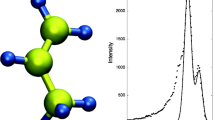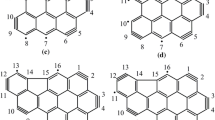Abstract
The dissociation and adsorption of molecular hydrogen on the edges of graphene nanoribbons of widths of 1.14 and 1.36 nm, is investigated within the density functional formalism. Here, graphene nanoribbons are used as models for the pore walls of some nanoporous carbons (carbide-derived carbons among others) which have been shown to be formed by one-atom thick graphene layers interconnected among them and exhibiting exposed edges (López et al. in J Chem Phys 135:104706, 2011). The aim of this study is to shed some light on the contribution of the edges of the pore walls to the hydrogen storage capacity of nanoporous carbons. Nanoribbons with zigzag and armchair edge terminations have been considered. Molecular hydrogen dissociates and adsorbs atomically at the nanoribbon edges with no or small activation barrier. The adsorption energies per hydrogen molecule are quite large, 2.5 and 5.7 eV for armchair and zigzag edges, respectively. This indicates that the graphene edges are very reactive and will be saturated with hydrogen whenever available. However, under mild conditions of pressure and temperature hydrogen cannot be desorbed from the edges and, therefore, the edges do not contribute to the reversible storage capacity of the material. The magnetic properties of saturated and unsaturated ribbons are also discussed.









Similar content being viewed by others
References
Alonso JA, Arellano JS, Molina LM, Rubio A, López MJ (2004) Interaction of molecular and atomic hydrogen with single-wall carbon nanotubes. IEEE Trans Nanotechnol 3:304–310
Arellano JS, Molina LM, Rubio A, Alonso JA (2000) Density functional study of adsorption of molecular hydrogen on graphene layers. J Chem Phys 112:8114–8119
Arellano JS, Molina LM, Rubio A, López MJ, Alonso JA (2002) Interaction of molecular and atomic hydrogen with (5,5) and (6,6) single-wall carbon nanotubes. J Chem Phys 117:2281–2288
Barone V, Hod O, Scuseria GE (2006) Electronic structure and stability of semiconducting graphene nanoribbons. Nano Lett 6:2748–2754
Cabria I, López MJ, Alonso JA (2007) The optimum average nanopore size for hydrogen storage in carbon nanoporous materials. Carbon 45:2649–2658
Cabria I, López MJ, Alonso JA (2011) Simulation of the hydrogen storage in nanoporous carbons with different pore shapes. Int J Hydrogen Energy 36:10748–10759
DACAPO (2009) See https://wiki.fysik.dtu.dk/dacapo for a description of the total energy code, based on the density functional theory. Last accessed 31 Aug 2012
DOE (2009) Multi-year research, development and demonstration plan: planned program activities for 2005–2015. Technical plan-storage. updated april 2009 http://www1.eere.energy.gov/hydrogenandfuelcells/mypp/pdfs/storage.pdf. Last accessed 31 Aug 2012
Fernández-Rosier J, Palacios J (2007) Magnetism in graphene nanoislands. Phys Rev Lett 99:177204
Froudakis GE (2002) Hydrogen interaction with carbon nanotubes: a review of ab initio studies. J Phys Condens Matter 14:R453
Fujita M, Wakabayashi K, Nakada K, Kusakabe K (1996) Peculiar localized state in zigzag graphite edge. J Phys Soc Jpn 65:1920–1923
Gogotsi Y, Dash RK, Yushin G, Yildirim T, Laudisio G, Fischer JE (2005) Tailoring of nanoscale porosity in carbide-derived carbons for hydrogen storage. J Am Chem Soc 127:16006–16007
Hammer B, Nørskov JK (1995) Electronic factors determining the reactivity of metal surfaces. Surf Sci 343:211–220
Hod O, Barone V, Scuseria GE (2008) Half-metallic graphene nanodots: a comprehensive first-principles theoretical study. Phys Rev B 77:035411
Kobayashi K (1993) Electronic structure of a stepped graphite surface. Phys Rev B 48:1757
Kobayashi Y, Fukui K, Enoki T, Kusakabe K, Kaburagi Y (2005) Observation of zigzag and armchair edges of graphite using scanning tunneling microscopy and spectroscopy. Phys Rev B 71:193406
Koskinen P, Malola S, Hakkinen H (2008) Self-passivating edge reconstructions of graphene. Phys Rev Lett 101:115502
Kusakabe K, Maruyama M (2003) Magnetic nanographite. Phys Rev B 67:092406
Linares-Solano A, Jordá-Beneyto M, Kunowsky M, Lozano-Castelló D, Suárez-García F, Cazorla-Amorós D (2008) Hydrogen storage in carbon materials. In: Terzyk AP, Gauden PA, Kowalczyk P (eds) Carbon materials: theory and practice. Research Signpost, Kerala, pp 245–281
López MJ, Cabria I, Alonso JA (2011) Simulated porosity and electronic structure of nanoporous carbons. J Chem Phys 135:104706
Ma Y, Lehtinen P, Foster A, Nieminen R (2004) Magnetic properties of vacancies in graphene and single-walled carbon nanotubes. New J Phys 6:68
Mañanes A, Duque F, Ayuela A, López MJ, Alonso JA (2008) Half-metallic finite zigzag single-walled carbon nanotubes from first principles. Phys Rev B 78:035432
Monkhorst H, Pack J (1976) Special points for brillouin-zone integration. Phys Rev B 13:5188
Nakada K, Fujita M, Dresselhaus G, Dresselhaus MS (1996) Edge state in graphene ribbons: nanometer size effect and edge shape dependence. Phys Rev B 54:17954–17961
Okada S (2008) Energetics of nanoscale graphene ribbons: edge geometries and electronic structures. Phys Rev B 77:041408
Perdew JP, Wang Y (1992) Accurate and simple analytic representation of the electron-gas correlation energy. Phys Rev B 45:13244
Pradhan BK, Sumanasekera GU, Adu KW, Romero HE, Williams KA, Eklund PC (2002) Experimental probes of the molecular hydrogen–carbon nanotube interaction. Phys B 323:115–121
Rode AV, Gamaly EG, Christy AG, Gerald JGF, Hyde ST, Elliman RG, Luther-Davies B, Veinger AI, Androulakis J, Giapintzakis J (2004) Unconventional magnetism in all-carbon nanofoam. Phys Rev B 70:054407
Shibayama Y, Sato H, Enoki T, Endo M (2000) Disordered magnetism at the metal-insulator threshold in nano-graphite-based carbon materials. Phys Rev Lett 84:1744
Son YW, Cohen ML, Louie SG (2006) Energy gaps in graphene nanoribbons. Phys Rev Lett 97:216803
Son YW, Cohen ML, Louie SG (2006) Half-metallic graphene nanoribbons. Nature (Lond) 444:347–349
Tao C, Jiao L, Yazyev OV, Chen YC, Feng J, Zhang X, Capaz RB, Tour JM, Zettl A, Louie SG, Dai H, Crommie MF (2011) Spatially resolving edge states of chiral graphene nanoribbons. Nat Phys 7:616–620
Vanderbilt D (1990) Soft self-consistent pseudopotentials in a generalized eigenvalue formalism. Phys Rev B 41:R7892
Vosko SH, Wilk L, Nusair M (1980) Accurate spin-dependent electron liquid correlation energies for local spin density calculations: a critical analysis. Can J Phys 58:1200–1211
Wu Q, Yang W (2002) Empirical correction to density functional theory for van der waals interactions. J Chem Phys 116:515–524
Yu D, Lupton E, Liu M, Liu W, Liu F (2008) Collective magnetic behavior of graphene nanohole superlattices. Nano Res 1:56–62
Acknowledgments
This study was supported by MICINN of Spain (Grants MAT2008-06483-C02-01 and MAT2011-22781) and Junta de Castilla y León (Grant VA158A11-2). IC acknowledges support from MEC of Spain through the Ramón y Cajal Program. CB acknowledges support from University of Valladolid through a Research Starting Program.
Author information
Authors and Affiliations
Corresponding author
Additional information
This article is part of the topical collection on nanomaterials in energy, health and environment
Rights and permissions
About this article
Cite this article
Bores, C., Cabria, I., Alonso, J.A. et al. Adsorption and dissociation of molecular hydrogen on the edges of graphene nanoribbons. J Nanopart Res 14, 1263 (2012). https://doi.org/10.1007/s11051-012-1263-0
Received:
Accepted:
Published:
DOI: https://doi.org/10.1007/s11051-012-1263-0




